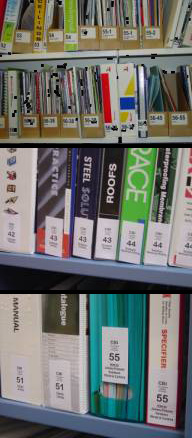CBI Technical Library
The CBI system on which Masterspec specification systems are based is equally suitable for the office technical library. The CBI (Co-ordinated Building Information) system has been in use now since 1998 and subject to only minor revision it remains as published.
CBI is a 4 level numbering system. Levels 1, 2 and 4 are the normally used levels.
Level 1
provides for material to be sorted into 8 classes. This will only suit offices with very small technical libraries.
Level 2
provides material to be sorted into some 50 groups. This level will suit most offices.
Level 4
provides hundreds of possible work sections into which data can be sorted. This level is generally too fine for most situations as manufacturers do not generally break their literature down to this level. Level 4 can be used in association with level 2. For example you could code the Gerrard Steel Tile Roofing manual as "4323". This can sit alongside other (not so specific) roofing literature as "43". Likewise GIB® plasterboard can be coded as "5113" and can sit alongside other linings coded as "51"
How do I start?
For some of you your library will be out-of-date. This can result in a specifier including non-current information into a project. Consider putting all of the technical literature that is older than 2 years into a pile and then ask the companies concerned to come and update their information. Any company who does not keep their material up to date is probably not worth including in your office projects.
Throw out material that you never use. There is no point in keeping such material and it is better to order current material as and when you require it.
Note other material that you will be storing in the office library - Standards, BRANZ bulletins and Good Practice Guides, the NZ Building Code and other technical publications, NZIA Architects Document Set and so on.
Make a decision on what you are going to do about samples. Are there some that will sit with the technical literature or should they all be stored somewhere else (out of sight).
Review what is left; you will have both hardback dedicated manuals as well as some soft cover material. You will need to purchase suitable "magazine boxes” for this material.
Labels

Print labels for the catalogues using the template provide by Masterspec . This is in Word format and can be easily modified. These labels have been formatted to print onto Avery DL33 labels. This is a standard size label that you may already have in your office. Check printing alignment with your printer. Note that the label sheets need to be inserted into the printer with the "scrap” at the bottom. Print as many pages as you require.
Fix labels to the catalogues. We suggest they be bottom aligned but set off the bottom so as not to catch on shelving. If the edges of the labels do not stick down, apply a wide-band clear sellotape over the label. Fix labels to 'magazine boxes' as required.
Where a catalogue covers more than one product, put it in the area that you most associate it with. For example waterproofing companies will include material relating to both 44 MEMBRANE ROOFING and 41 TANKING - you choose which one suits you best.
Labels sample
A pre-formatted CBI Lable Template (Microsoft® Word document ) is available for download.